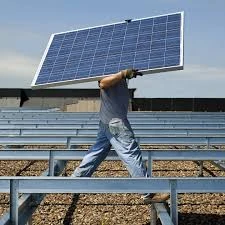solarpanel bifacial
The Advantages and Innovations of Bifacial Solar Panels
In the quest for sustainable energy solutions, solar power continues to emerge as a leading technology, with innovations paving the way for more efficient and versatile systems. One of the most promising advancements in solar technology is the development of bifacial solar panels. These panels harness sunlight from both sides, dramatically increasing their efficiency and energy output. As the global push for renewable energy intensifies, bifacial solar panels are garnering attention not only for their environmental benefits but also for their economic viability.
What Are Bifacial Solar Panels?
Bifacial solar panels are designed to capture sunlight on both their front and rear sides. Traditional solar panels generally collect light from one side, but bifacial panels utilize photovoltaic cells on both surfaces, allowing them to harness reflected sunlight from the ground and surrounding surfaces. This dual-sided design can lead to significant improvements in energy production, particularly in installations where high albedo (reflective surface) materials are used, such as white roofs, sandy soils, or light-colored concrete.
Efficiency Gains
The primary advantage of bifacial solar technology lies in its enhanced efficiency. Studies have shown that bifacial panels can achieve a power increase of 10% to 20% compared to their mono-facial counterparts, depending on installation conditions. This efficiency gain is particularly pronounced in areas with ample sunlight and reflective surfaces. For example, a bifacial solar array installed in a desert environment with a light-colored sandy substrate can benefit vastly from the sunlight reflected off the ground, maximizing the energy harnessed.
Economic Benefits
While the initial investment in bifacial solar panels may be higher than traditional options, the long-term economic benefits are substantial. The increased energy output can lead to faster returns on investment and lower levelized costs of energy (LCOE). Additionally, as technology continues to advance and the manufacturing process becomes more refined, the price disparity is expected to decrease, making bifacial panels even more financially attractive.
solarpanel bifacial

Furthermore, the durability of bifacial solar panels tends to be superior. Manufacturers often use robust materials to construct these panels, making them more resistant to harsh environmental conditions. This durability can translate into lower maintenance costs and extended lifespans, ensuring that investments yield energy over more extended periods.
Installation Flexibility
Another distinctive feature of bifacial solar panels is their installation versatility. These panels can be installed in various configurations, including fixed tilt, tracking systems, or on elevated structures, providing flexibility suited to different environments. For example, in utility-scale solar farms, using bifacial modules mounted on raised structures can optimize energy production, allowing the ground below for dual-use purposes such as agriculture or livestock grazing.
Environmental Impact
As the world grapples with climate change and a growing demand for renewable energy sources, bifacial solar panels represent a significant step toward sustainability. By maximizing energy production from sunlight, these panels enable more efficient use of land and resources. Additionally, since they generate more power in the same footprint, they help reduce the overall land requirements for solar installations, which is critical in areas where land is scarce or expensive.
Furthermore, as energy authorities worldwide aim to reduce carbon emissions, harnessing solar power through innovative technology like bifacial panels helps in achieving societal climate goals. Integrating these panels into the existing energy grid paves the way for a cleaner, greener future.
Conclusion
In conclusion, bifacial solar panels are transforming the landscape of solar energy production, offering elevated efficiency, economic benefits, installation flexibility, and a lower environmental impact. As advancements continue and adoption rates increase, bifacial technology presents a promising solution to meet the rising global demand for clean energy. It stands as a testament to human ingenuity in overcoming energy challenges while working toward a more sustainable future. As stakeholders in the renewable energy sector embrace these innovations, the potential for bifacial solar panels to play a pivotal role in the global energy transition remains immense.
-
Navigating Off Grid Solar Inverter: From Use Cases to Trusted PartnersNewsAug.05,2025
-
Solar Edge String Inverter: A Wholesaler’s Guide to Inverter Technology SelectionNewsAug.05,2025
-
Microinverters: Revolutionizing Solar Energy UseNewsAug.05,2025
-
Future of Monocrystalline Solar Panel Efficiency: Latest Technological AdvancesNewsAug.05,2025
-
Solar Panels for House: A Complete Guide to Residential Solar EnergyNewsAug.05,2025
-
Panel Bifacial Performance in Snow and Low-Light ConditionsNewsAug.05,2025







